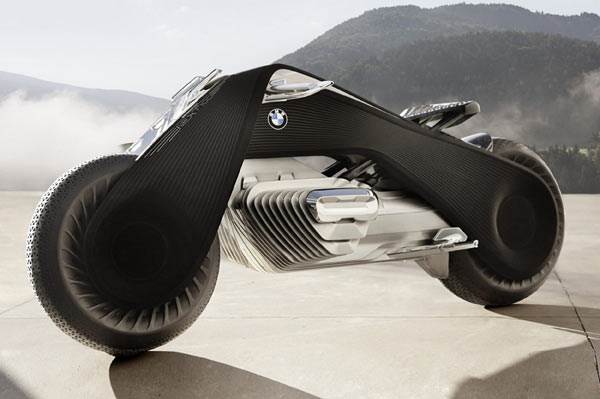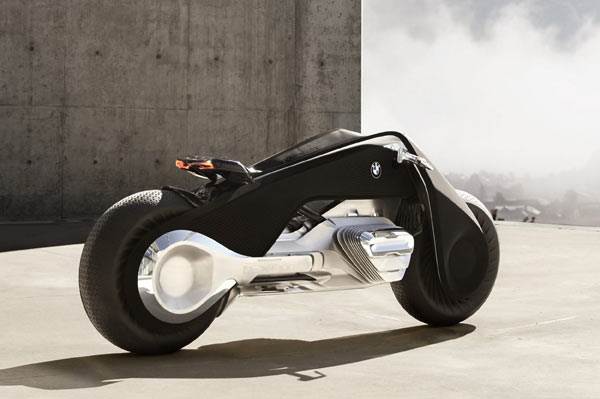Following the BMW, Mini and Rolls-Royce Vision vehicles, the BMW Group has now revealed its next progressive solution for the world of motorcycling: the BMW Motorrad Vision Next 100. The concept motorcycle was unveiled on October 11 at the “Iconic Impulses The BMW Group Future Experience” exhibition in Los Angeles.
Commenting on the unveiling, Edgar Heinrich, head of design at BMW Motorrad, said: “The BMW Motorrad VISION NEXT 100 embodies the BMW Group’s vision of biking in a connected world – an analogue experience in a digital age. Motorcycling is about escaping from the everyday: the moment you straddle your bike, you are absolutely free. Your bike is The Great Escape.”
The concept liberates the rider from the need to wear a helmet and protective clothing. The elements in the BMW Motorrad Vision Next 100 make it recognisable and include the black frame triangle, white lines and classic, boxer engine forms. The bike, however, is powered by a zero-emissions solution.
The frame triangle – a classic reinvented
The black frame triangle of the BMW Motorrad Vision Next 100 is a deliberate reference to the first ever BMW motorcycle, the R32, made in 1923. On the vision bike, however, it has been reinterpreted to form a functional sculpture linking the front and rear wheels with a sweep. Bearings and joints are nowhere to be seen; instead the frame appears as a single, integrated whole.
The BMW logo is optimally displayed on the dark frame. It is illuminated in the familiar blue and white colours while driving.
Flexframe – frame-assisted steering
The Flexframe appears as a single, integrated whole that extends from the front to the rear wheel of the bike. Being flexible, it allows the bike to be steered without the various joints found on today’s motorcycles. Turning the handlebar adjusts the entire frame, changing the direction of the bike. The amount of strength needed to steer depends on the situation: at standstill, the Flexframe allows a light steering whereas at higher speeds it remains very rigid.
Powertrain – inspired by the BMW boxer engine
In the middle of the triangle frame sits a historical reminder: the power unit. Designed and created in the image of the traditional BMW boxer engine, it actually consists of a zero-emissions drive unit. Its outward appearance changes depending on the circumstances: when the bike is resting, the power unit is compact, extending outwards only when the bike sets off, to enhance aerodynamics and protect the rider from the elements.
Minimalist form, maximum details
Body elements such as the seat, upper frame cover and wings are made of carbon. Beneath the seat shell, two fine, red, illuminated strips form the rear light and indicators - picking up on the typical double-C form of the rear lights on today’s BMW bikes.
Self-balancing assistant systems
In certain situations, the active assistance systems of the future will also enhance stability and safety by automatically balancing the motorcycle, both out on the road and when stationary. Novice riders will benefit from additional guidance in all riding situations and from a bike that will never tip over.
The concept bike rights itself while even stationary, remaining upright when the rider has dismounted. The balancing systems also work out on the road to ensure a particularly agile and dynamic riding experience with even lighter handling, which seasoned riders will appreciate, and all the benefits of assistance systems to enhance their capabilities even further.
“A key point with the BMW Motorrad Vision Next 100 was to make sure the constant digital presence doesn’t undermine the analogue riding experience. The display and operating concept works so subtly that the rider can enjoy an entirely natural biking experience, trusting the bike completely and enjoying complete freedom and ease. As interface designers, our job is to deliver the right amount of the right information at the best possible time and place," said Holger Hampf, head of user experience at the BMW Group.
The visor
Information exchanges between rider and bike take place largely via the visor. This essentially consists of a pair of data glasses that extends across the wearer’s entire field of vision. As well as providing wind protection, it shows relevant data in one of four designated display areas. These are controlled by the rider’s eye movements: looking up or down changes the content that appears, and looking straight ahead switches the information off completely, leaving the rider to focus even more fully on biking experience. Information is only projected onto the visor on request, or to alert the rider to the fact that action is needed.
Looking upwards activates the rear-view function in the visor, allowing the rider to see what is going on on the road behind. Lowering the eyes to normal levels opens a menu from which the rider can select an option by pointing a finger. Looking further down opens the map view showing the rider’s chosen route.
Rider’s equipment
The rider’s gear accompanying the BMW Motorrad Vision Next 100 is integral to the unique overall experience. In classic black and white, the airy suit enhances the sense of freedom and is both fashion statement and weather-wear. Depending on conditions, it warms or cools the user. While the diagonal zipper across the chest is reminiscent of traditional motorcycle clothing, the flexible, banded structure of the suit and shoes is inspired by the muscle areas of the human body and provides body support and relief whenever needed.
At higher speeds, the neck section inflates to provide extra support for the upper vertebrae and improve overall comfort. Variable openings offer additional ventilation.





Comments
Member Login
Personal Details
No comments yet. Be the first to comment.